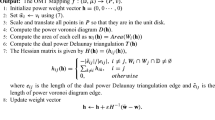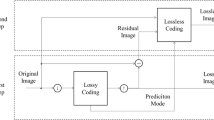Abstract
Normal mapping is an essential rendering technique in 3D computer graphics to express detailed wrincleness and bumpy texture of the surface. As the normal mapping is increasingly utilized, compression of normal maps is becoming a significant issue. The problem is there is no quality evaluation model for lossy compressed normal maps. Therefore, in this paper, we have developed a mathematical model to analyze the characteristics between lossy compressed normal maps and 3D images rendered with them. By calculating averages of the parameters which cannot be defined uniquely and by introducing some assumptions, the model has been expressed in a simple form. The validity and generality of our model have been demonstrated by experiments. The model proposed in this paper will be helpful for deciding normal map compression strategy considering the target quality of the rendered 3D images.
Preview
Unable to display preview. Download preview PDF.
Similar content being viewed by others
References
Blinn, J.F.: Simulation of wrinkled surfaces. In: Proc. the 5th annual conference on Computer graphics and interactive techniques, vol. 12(3), pp. 286–292 (1978)
Foley, J.D., Dam, A., Feiner, S.K., Hughes, J.F.: Computer Graphics PRINCIPLES AND PRACTICE, 2nd edn. Addison-Wesley Publishing Company, Reading (1996)
Blinn, J.F.: Texture and Reflection in Computer Generated Images. Comm. ACM 19(10), 542–547 (1976)
Miller, G.S., Hoffman, C.R.: Illumination and Reflection Maps: Simulated Objects in Simulated and Real Environments. In: Proc. Siggraph 1984, Course Notes for Advanced Computer Graphics Animation. ACM Press, New York (1984)
Oliveira, M.M., Bishop, G., McAllister, D.: Relief texture mapping. In: Pros. Siggraph 2000, Computer Graphics Proceedings, pp. 359–368 (2000)
Kilgard, M.J.: A practical and robust bump-mapping technique for today’s GPUs. In: Game Developers Conference, Advanced OpenGL Game Development (2000)
Peercy, M., Airey, A., Cabral, B.: Efficient Bump Mapping Hardware. In: Proceedings of SIGGRAPH 1997, August 3-8, pp. 303–306 (1997)
Ikedo, T., Ohbuchi, E.: A Realtime Rough Surface Renderer. In: Proc. of Computer Graphics International 2001 (CGI 2001), pp. 355–358 (2001)
Miller, G., Halstead, M., Clifton, M.: On-the-Fly Texture Computation for Real-Time Surface Shading. IEEE Computer Graphics and Applications 18(2) (March-April 1998)
Dischler, J.M., Ghazanfarpour, D.: A survey of 3D texturing. Computer & Graphics 25, 135–151 (2001)
Smith, M.L., Hill, T., Smith, G.: Surface texture analysis based upon the visually acquired perturbation of surface normals. Image and Vision Computing 15, 949–955 (1997)
Oh, S.T., Lee, K.H.: Bump map generation from 3D scan data. In: Proceedings of the 2003 International Conference on Geometric Modeling and Graphics, pp. 180–185 (2003)
Yamasaki, T., Hayase, K., Aizawa, K.: Mathematical Error Analysis of Normal Map Compression Based on Unity Condition. In: Proceedings of 2005 IEEE International Conference on Image Processing (ICIP 2005), September 11-14 (2005) (accepted)
Nakamura, R., Yamasaki, T., Aizawa, K.: JPEG Optimization for Efficient Bump Map Compression. In: Proc. of the 2005 IEICE General Conf., March 2005, pp. D-11–17 (2005) (in Japanese)
Green, S.: Bump Map Compression Whitepaper (October 2004), http://download.nvidia.com/developer/Papers/2004/Bump_Map_Compression/Bump_Map_Compression.pdf
ATI RADEON X800 3Dc white paper, http://www.ati.com/products/radeonx800/3DcWhitePaper.pdf
Bump Texture Library, Computer Graphics Systems Development Corporation, http://cgsd.com/
Author information
Authors and Affiliations
Editor information
Editors and Affiliations
Rights and permissions
Copyright information
© 2005 Springer-Verlag Berlin Heidelberg
About this paper
Cite this paper
Yamasaki, T., Hayase, K., Aizawa, K. (2005). Mathematical PSNR Prediction Model Between Compressed Normal Maps and Rendered 3D Images. In: Ho, YS., Kim, HJ. (eds) Advances in Multimedia Information Processing - PCM 2005. PCM 2005. Lecture Notes in Computer Science, vol 3768. Springer, Berlin, Heidelberg. https://doi.org/10.1007/11582267_51
Download citation
DOI: https://doi.org/10.1007/11582267_51
Publisher Name: Springer, Berlin, Heidelberg
Print ISBN: 978-3-540-30040-3
Online ISBN: 978-3-540-32131-6
eBook Packages: Computer ScienceComputer Science (R0)




